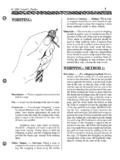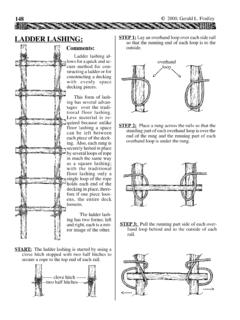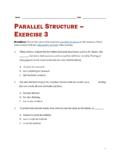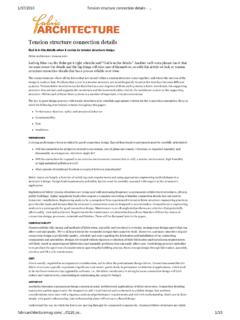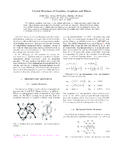Transcription of SQUARE LASHING: In most cases the force applied to a ...
1 1999, Gerald L. FindleyROPE WORKS + TSQUARE LASHING: Use ---- To bind poles that are in contact and crosseach other at any angle from 45o to ---- The SQUARE lashing gets it namefrom the fact that the wrapping turns are at 90oor " SQUARE " to the SQUARE lashing is the most fre-quently used and the most secure form of lash-ing. If tied properly, the SQUARE lashing willremain tight and secure, but, as with all lash-ings, if any steps are omitted or done carelessly,the lashing will loosen and create a SQUARE lashing can be used to bindpoles together that cross and contact each otherat any angle from 45o to 90o. If the angle ofcontact is greater than 45o, a shear lashingshould be tying a SQUARE lashing , the poles andthe rope must be positioned properly to achievethe maximum strength.
2 The cross pole should-------> force <------------->running end----->be position so that the force applied to the crosspole is directed toward the pole it is lashed to;this allows the wood to wood contact to barepart of the lode; if the force tends to separatethe poles, only the rope will be supporting theload. The beginning clove hitch should be tiedto the pole that is closest to parallel to the di-rection of the force and to the side of the crosspole that is opposite to the direction of the most cases the force applied to a structure isdue to gravity, therefore downward, this meansthat the beginning clove hitch is usually tied tothe vertical pole, and under the cross pole. Thestanding end of the rope is secured by wrap-ping it around the running ------ (For SQUARE lash knotboard.)(1) Tie a clove hitch to the vertical pole.
3 (2)Wrap the standing end of the rope around therunning end [NOTE] The wrapping of thestanding part around the running part is to se-cure the clove hitch so that it will not sliparound the pole and loosen the lashing fromthe inside. (3) Bring the running end up andover the cross pole; then around the verticalpole; and back down over the cross pole. (4)Pass the rope behind the vertical pole and backup in front of the cross pole; this completes thefirst wrapping. [NOTE] Notice that the ropegoes around the pole perpendicular, at 90o, tothe length of the pole. This 90o angle gives thesquare lashing its name. (5) Take two morewrapping turns for a total of three wrappings:pull each turn tight. [NOTE] When the wrap-pings are taken around the vertical pole the ropeshould be to the inside of the previous wrap-ping turn; and the wrappings around the crosspole should be to the outside of the previouswrapping turn.
4 When this pattern of taking thewrapping turns is followed the rope strands re-main parallel; this insures the maximum con-tact between the wood and the rope. Also ifthe strands are not kept parallel, the additionalfriction between the crossed strands will makeit difficult to properly tighten the wrappingturns. (6) Start the frapping turns by taking onewrapping 1wrapping 2wrapping 3crosspole---->--->------->--------->ver ticalpole<------clove hitch<-----<--wrapping 2<--wrapping 1wood to wood contactstandingendclovehitch 1999, Gerald L. FindleyROPE WORKS + Tkeeping tension on the running end pull it inthe opposite direction so that the loop of thehalf hitch will slip around the pole. This takesup any slack left in the rope. Work the runningend back and forth in this way until the halfhitch is locked tight against the lashing .
5 If thishalf hitch is not locked against the lashing theending clove hitch can slip around the pole al-lowing the lashing to loosen. (9) Add a secondhalf hitch to form a clove hitch around the crosspole; work half hitch >pullsecond half hitch---------->halfhitch------------sta ndingendrunningend-----pull<---------com plete turn around the cross pole; [NOTE]The turn around the cross pole prevents the ropefrom crossing the wrapping turns on a diago-nal. If the change of direction between thewrapping turns and the frapping turns is madeby passing the rope diagonally across the wrap-ping turns, the increased friction between therope strands will make it difficult to pull thewrapping turns tight. A diagonal across thewrapping turns will also allow unnecessarymovement within the completed lashing , whichcould cause chaffing of the rope.
6 (7) Take atleast two frapping turns; keep the turns paral-lel to each other; pull each turn tight as it ismade. [NOTE] Keeping the frapping turnsparallel prevents unnecessary friction betweenthe turns making it easier to tighten the frap-ping turns. (8) When the last frapping turn isin place, take a half hitch around the cross pole,work the half hitch tight. [NOTE] To preventthe rope from crossing the wrapping turns di-agonally when tying the half hitch, take the ropepast the cross pole on the same plain as thefrapping turns, then around the cross pole.[NOTE] To work the half hitch tight, first pullthe running end toward the standing end. Thiswill tighten the frapping turns. Next, while[NOTE] If smooth rope is being used a third halfhitch added to the clove hitch will help insurethat the lashing will stay securely in place.
7 1999, Gerald L. FindleyROPE WORKS + T+ + SQUARE lashing + +clove endstart 2 frapping 1sthalf hitchtight1sthalf hitchwork tightto formclove 3 wrapping turns.


